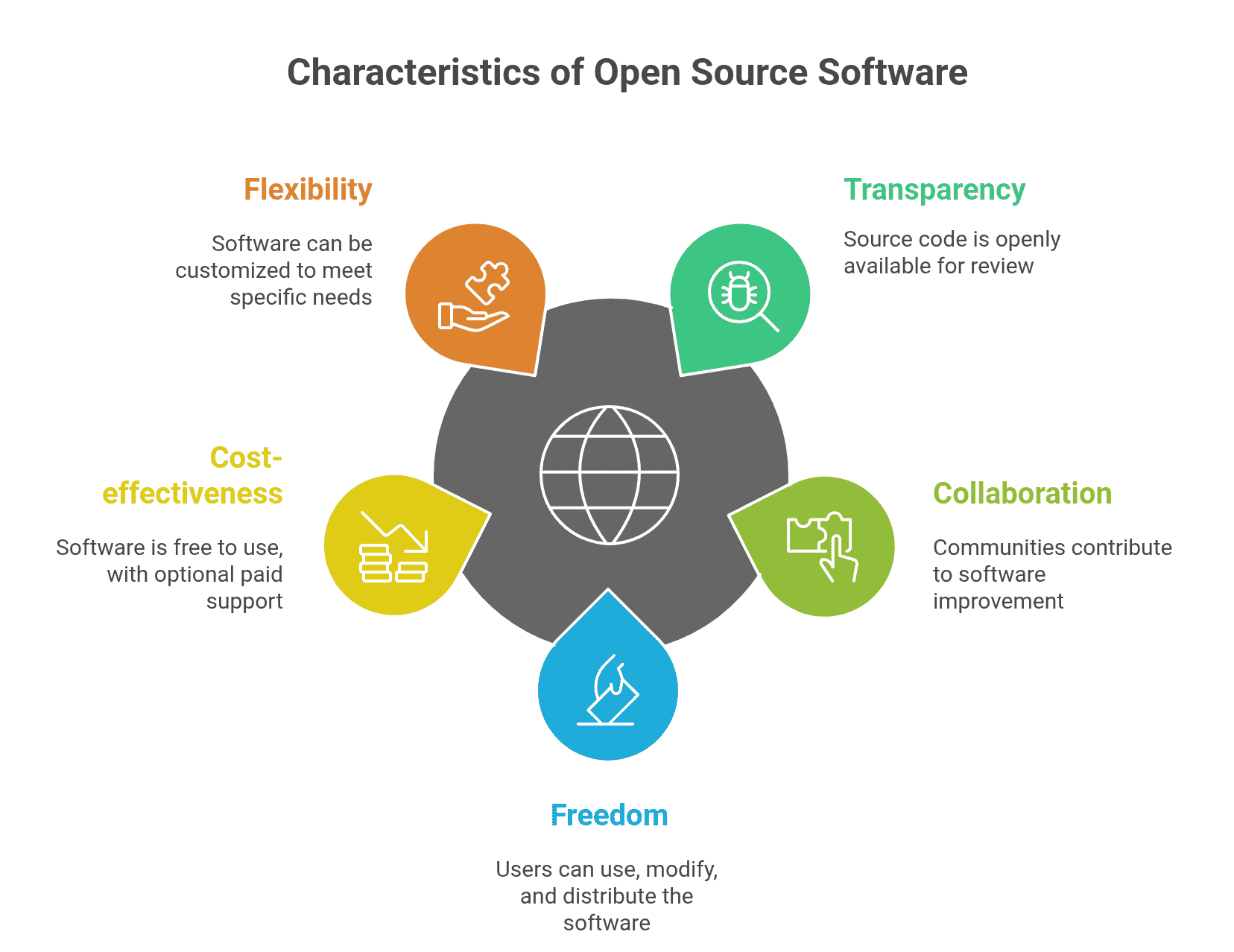In today’s competitive business landscape, open source software has become a cornerstone of digital transformation. From startups to Fortune 500 companies, organizations are leveraging open source solutions to reduce costs, accelerate innovation, and maintain technological flexibility. This guide explores the essential open source software that can revolutionize your business operations.
What is Open Source Software
Open source software (OSS) is software with source code that anyone can inspect, modify, and enhance. Unlike proprietary software, where the code is closely guarded, open source software makes its underlying code available to the public under licenses that grant users the freedom to use, study, change, and distribute the software to anyone for any purpose.
The open source philosophy is built on collaborative development and transparency. When programmers access the source code, they can improve it by adding features, fixing bugs, or adapting it to new purposes. This collaborative approach has led to the development of some of the most robust and widely used software in the world.
Key characteristics of open source software include:

- Transparency: The source code is openly available for review and audit
- Collaboration: Communities of developers contribute to improvement and innovation
- Freedom: Users have the liberty to use, modify, and distribute the software
- Cost-effectiveness: Most open source software is free to use, though support services may require payment
- Flexibility: Organizations can customize the software to meet specific business needs
Open source software powers much of the modern internet infrastructure, from web servers and databases to operating systems and development tools. Major tech companies, such as Google, Facebook, and Microsoft, not only utilize open-source software but also contribute significantly to open-source projects.
Decoding Open Source Licenses
Understanding open source licenses is crucial for businesses adopting OSS. These licenses define how software can be used, modified, and distributed. Not all open source licenses are created equal, and choosing the wrong license can have significant legal and operational implications.
Major Types of Open Source Licenses:
Permissive Licenses grant broad permissions with minimal restrictions. These licenses allow you to use the code in proprietary software without requiring you to open source your modifications.
- MIT License: One of the most permissive licenses, allowing almost unrestricted use
- Apache License 2.0: Similar to MIT, but includes explicit patent grants and protections
- BSD Licenses: Family of permissive licenses with minimal requirements
Copyleft Licenses require that any derivative works also be distributed under the same license terms. This ensures that modifications remain open source.
- GNU General Public License (GPL): Strong copyleft requiring derivative works to be open-sourced
- Lesser GPL (LGPL): Allows linking with proprietary software without triggering copyleft
- Affero GPL (AGPL): Extends GPL to cover network use cases
Important Considerations for Businesses:
When selecting open-source software, carefully evaluate the license implications. Permissive licenses offer maximum flexibility for commercial use and integration with proprietary systems. Copyleft licenses ensure continued openness but may restrict how you can distribute derivative works.
Always maintain accurate records of which open source components you use and their respective licenses. Many organizations use software composition analysis tools to track dependencies and ensure compliance. Consult with legal counsel when incorporating open source software into commercial products, especially with copyleft licenses.
10 Essential Open Source Solutions for Modern Businesses
1. Linux Operating System
Linux dominates the server market and powers everything from web servers to supercomputers. Its stability, security, and flexibility make it the backbone of modern IT infrastructure. Distributions like Ubuntu, Red Hat Enterprise Linux, and CentOS offer enterprise-grade support and long-term stability.
Business Benefits: Reduced licensing costs, superior security, extensive customization options, and massive community support.
2. Docker & Kubernetes
Docker revolutionized application deployment through containerization technology, enabling developers to package applications with all dependencies. Kubernetes, Google’s container orchestration platform, automates the deployment, scaling, and management of containerized workloads at scale.
Business Benefits: Faster deployment cycles, automated scaling, improved resource utilization, self-healing capabilities, and reduced infrastructure costs.
3. PostgreSQL
This advanced open source relational database system rivals commercial databases in performance and features. PostgreSQL excels at handling complex queries and large datasets with full ACID compliance.
Business Benefits: Enterprise-grade reliability, advanced data types, excellent scalability, and zero licensing costs regardless of company size.
4. Git and GitLab
Git revolutionized version control, while GitLab provides a comprehensive DevOps platform. These tools enable collaborative development, CI/CD pipelines, and complete project management.
Business Benefits: Distributed development workflows, complete project history, integrated development tools, and automated deployment pipelines.
5. Rocket.Chat
An open source team communication platform that serves as an alternative to Slack or Microsoft Teams. Rocket.Chat offers real-time messaging, video conferencing, file sharing, and integrations with hundreds of tools.
Business Benefits: Complete data ownership and privacy, unlimited users and messages, custom branding options, and no per-user fees.
6. Mattermost
A secure, open source collaboration platform designed for technical and operations teams. Mattermost excels in DevOps workflows with deep integrations for CI/CD pipelines, incident management, and automated workflows.
Business Benefits: Military-grade security, self-hosted control, extensive API and webhook support, and seamless developer tool integrations.
7. Taskosaur
The world’s first AI-powered open source project management tool that executes workflows through natural conversation. Instead of navigating complex menus, simply tell Taskosaur what you need in plain language and watch it happen automatically. It understands context, creates sprints, assigns tasks based on expertise, and automates workflows.
Business Benefits: Self-hosted with 90% cost savings compared to traditional tools, natural language commands that actually execute (not just suggest), use your own AI keys, no per-seat fees, and complete source code access for customization.
8. Odoo
An all-in-one open source business management suite that includes CRM, e-commerce, accounting, inventory, point of sale, project management, and more. Odoo’s modular approach lets businesses start small and expand as needed.
Business Benefits: Integrated business processes, modular scalability, extensive third-party apps, a modern user interface, and eliminates the need for multiple separate systems.
9. SuiteCRM
A comprehensive open source CRM solution offering sales force automation, marketing campaigns, customer support, and reporting. SuiteCRM provides enterprise CRM capabilities without the enterprise price tag.
Business Benefits: Full-featured CRM functionality, unlimited users, customizable modules and workflows, mobile access, and integration with email and calendar systems.
10. WordPress
WordPress powers over 40% of all websites globally, from small blogs to enterprise content platforms. Its extensive plugin ecosystem and user-friendly interface make it ideal for businesses of all sizes.
Business Benefits: Rapid website deployment, extensive customization through themes and plugins, strong SEO capabilities, and no licensing fees.
How Open Source Software Drives Business Success
1. Cost Optimization and Financial Flexibility
- Eliminates expensive licensing fees, freeing budget for strategic priorities.
- Avoids vendor lock-in and costly upgrade cycles.
- Redirects savings toward innovation, talent acquisition, or growth initiatives.
2. Accelerated Innovation and Time-to-Market
- Leverages mature open source projects as foundations.
- Frees development teams to focus on unique features rather than reinventing common functionality.
- A vast ecosystem of tools and frameworks accelerates development cycles.
3. Enhanced Security Through Transparency
- Community review identifies vulnerabilities faster than proprietary software.
- Organizations can audit code internally or via third parties.
- Critical security patches often arrive quickly due to active open source communities.
4. Talent Attraction and Development
- Developers prefer modern open source technologies over legacy systems.
- Recruiting is easier with widely used open source tools.
- Contributing to open source enhances team skills and company reputation.
5. Community Support and Ecosystem
- Large communities provide documentation, tutorials, and troubleshooting.
- Community support often surpasses proprietary vendor assistance.
- Complementary tools and integrations add significant business value.
6. Customization and Control
- Software can be modified to meet specific business needs.
- Maintains full control over the technology stack.
- Ensures long-term support even if original maintainers leave.
7. Strategic Independence
- Reduces reliance on a single vendor.
- Enables flexibility to switch hosting providers or support vendors.
- Supports scaling and evolving business needs without restrictions.
FAQ
1. What is Open Source Software?
Software with publicly available source code that anyone can use, modify, and share. It promotes collaboration and transparency.
2. What are the benefits of Open Source Software?
Cost savings, security through community review, customization, freedom from vendor lock-in, access to innovations, and community support.
3. What is the most popular open-source software?
Linux, WordPress, MySQL/PostgreSQL, Apache/Nginx, Docker/Kubernetes, Git, Python, JavaScript, and Android.
4. Does NASA use open-source software?
Yes. NASA uses and contributes to open source for data analysis, mission planning, robotics, and scientific computing.
5. How do you create a business out of an open source technology?
Through support services, managed hosting, proprietary extensions, dual licensing, SaaS products, or enterprise features. Examples: Red Hat, GitLab, MongoDB.
6. Is Apache an OSS?
Yes. Apache HTTP Server and many other projects are open source under the permissive Apache License 2.0.
7. What are examples of open source software?
Linux, FreeBSD, Apache, Nginx, MySQL, PostgreSQL, Python, Git, WordPress, LibreOffice, Firefox, GIMP, Docker, Kubernetes, and thousands more.





Leave A Comment